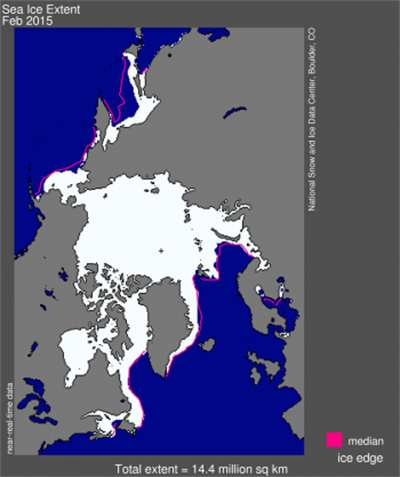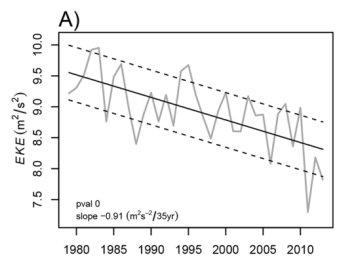
Scientists link Arctic warming to intense summer heatwaves in the northern hemisphere
Roz Pidcock
03.12.15Roz Pidcock
12.03.2015 | 6:00pmThe Arctic is warming up, and the impacts are being felt right across the world. A new study suggests rising temperatures there could even be contributing to longer-lasting heatwaves in the northern hemisphere, like the one Russia experienced in 2010.
Published today in the journal Science, the paper is the latest in a line of research suggesting how rising temperatures in the high north could be affecting our weather patterns much further south.
But there’s a lot still to understand before the links can be well and truly pinned down, scientists say.
Extreme Arctic warming
The Arctic is warming at least twice as fast as the globe as a whole. Scientists begun noticing the pattern emerge in temperature records since about the year 2000. It’s known as Arctic Amplification.
Part of the reason for it is that, as sea ice is diminishing, heat from the sun that would have been reflected back to space by snow and ice is being absorbed by the oceans instead, warming them up.
As the Arctic warms faster than the rest of the world, the temperature difference between the pole and the equator is getting smaller. Since this temperature contrast drives much of the atmospheric circulation in the northern hemisphere, the smaller it gets, the weaker the circulation becomes.
These atmospheric circulation patterns are responsible for delivering the weather systems that create warm, cold or wet conditions in the northern hemisphere. So, it follows that disrupting the circulation will, in turn, have consequences for the weather we see.

Arctic sea ice extent for February 2015 was 14.41 million square kilometers. The magenta line shows the 1981 to 2010 median extent for that month. Source: NSIDC
Winter or summer
Most of the work on Arctic Amplification has focused implications for winter weather. This is when the biggest effects are expected because the extra heat stored in the Arctic Ocean gets released back to the atmosphere in late autumn or winter, when the air temperature drops below the water temperature.
Prof Jennifer Francis from the University of Rutgers in New Jersey (not an author of this latest paper) has led in a lot of the recent research into how a weakening circulation could result in more extreme northern hemisphere winters.
The theory is that as the jet stream – a river of high-speed winds flowing west to east high up in the atmosphere – slows down it meanders more, causing weather patterns to stick around for longer.
While the theory seems robust, it’s debated whether or not scientists are seeing evidence of it in action. Findings seem to be sensitive to the method a particular study uses, the new paper explains.
A new approach
The new paper doesn’t dispute the jet stream mechanism for how Arctic warming can affect northern hemisphere extreme weather, but it puts forward a different one.
First, the scientists look at the impacts on summer weather, not winter weather. Dr James Screen, specialist in Arctic changes and the impacts for midlatitude weather at the University of Exeter, tells Carbon Brief:
“This paper focuses on summer and heat waves when a lot of the previous work has looked at winter and cold extremes. Summer warming due to sea ice loss is known to be quite small. However, this is the time of year when changes in snow cover may have a larger impact.”
As well as focusing on a different season, the new paper describes a different mechanism to past research, Screen says.
Rather than causing the jet stream to meander, sluggish atmospheric circulation is associated with a reduced amount of energy available at smaller scales, meaning that fewer storms form.
Scientists can estimate changes in storminess using something called the eddy kinetic energy (EKE). Calculations in the new paper show a steady decline in summer EKE by 8 to 15 per cent since the start of the satellite period in 1979.

Eddy Kinetic Energy (a measure of storminess) has decreased steadily since 1979. Source: Coumou et al., ( 2015)
With fewer storms passing over continents, there’s nothing to break up persistent weather patterns, Dr Dim Coumou, researcher in extreme weather and climate change at the Potsdam Institute for Climate Impact Research and lead author on the new paper, tells Carbon Brief.
“In summer, cyclones bring cool and moist air from the oceans to the continents and they can thus bring relief after periods of oppressive heat. And a lack of them favors the buildup of heat and drought over the continents.”
This likely prolongs the duration of blocking weather systems, such as the Russian heatwave in 2010, Coumou explains. The record breaking July temperatures over Moscow that year were associated with extremely low storminess, the paper notes.
Fewer storms
A decline in summer storminess is consistent with model projections of the impacts of a warming Arctic, the paper explains. While this is reasonably convincing and consistent with model projections, Screen recommends being cautious about pinning the blame on Arctic warming.
That’s because storminess depends on many factors and it’s not yet clear if the changes we’re seeing can be linked definitively to Arctic Amplification, or whether they’re due to some other factor. How the temperature varies vertically in the atmosphere also has an impact, for example. Screen says:
“[C]hanges in any (or all) or these could lead to a change in storminess.”
Last year, Coumou and colleagues had a separate paper suggesting persistent summer heatwaves may be linked to the meandering jet stream mechanism. This link to storminess is a different mechanism altogether. This all makes for quite a confusing picture, Screen tells Carbon Brief:
“There is still of a uncertainty about these potential linkages and lots of contrasting hypotheses. In my mind, the link to decreased storminess makes more physical sense and is supported by model projections of a warming climate (whereas the planetary wave hypothesis is, in my opinion, more speculative).”
A long way to go
Today’s paper adds to growing evidence that mid-latitude circulation is changing, Coumou concludes. But there’s a long way to go. More work needs to be done to understand exactly how it’s changing, what’s driving the changes and how strong they are compared to other drivers of extreme weather. But the new paper suggests the impacts probably won’t just be limited to autumn and winter.
Main image: Woman enjoy the cold waters of fountain during a heat wave.
Coumou, D. et al., (2015) The weakening summer circulation in the Northern Hemisphere mid-latitudes. Doi: 10.1126/science.1261768
-
Scientists link Arctic warming to intense summer heatwaves in the northern hemisphere

